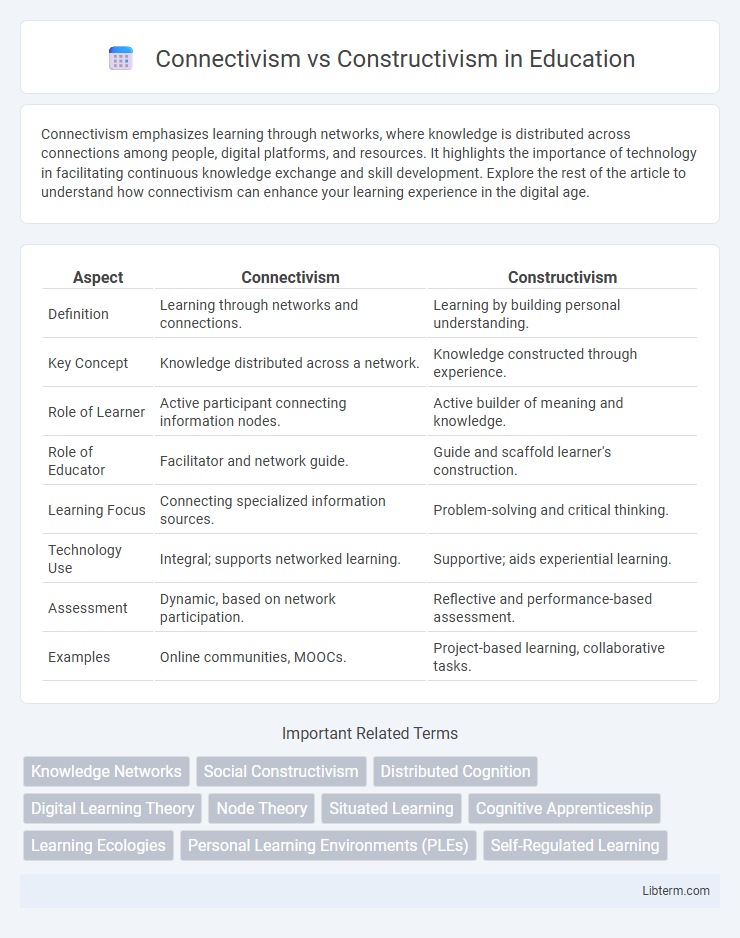Connectivism emphasizes learning through networks, where knowledge is distributed across connections among people, digital platforms, and resources. It highlights the importance of technology in facilitating continuous knowledge exchange and skill development. Explore the rest of the article to understand how connectivism can enhance your learning experience in the digital age.
Table of Comparison
| Aspect | Connectivism | Constructivism |
|---|---|---|
| Definition | Learning through networks and connections. | Learning by building personal understanding. |
| Key Concept | Knowledge distributed across a network. | Knowledge constructed through experience. |
| Role of Learner | Active participant connecting information nodes. | Active builder of meaning and knowledge. |
| Role of Educator | Facilitator and network guide. | Guide and scaffold learner's construction. |
| Learning Focus | Connecting specialized information sources. | Problem-solving and critical thinking. |
| Technology Use | Integral; supports networked learning. | Supportive; aids experiential learning. |
| Assessment | Dynamic, based on network participation. | Reflective and performance-based assessment. |
| Examples | Online communities, MOOCs. | Project-based learning, collaborative tasks. |
Introduction to Learning Theories
Connectivism emphasizes learning through networked connections and digital environments, while Constructivism centers on learners actively constructing knowledge through experiences. Both theories highlight the learner's role but differ in the context and tools used for knowledge acquisition. Introduction to learning theories requires understanding these paradigms to effectively design modern educational strategies.
Overview of Constructivism
Constructivism is a learning theory emphasizing that knowledge is actively constructed by learners through experience and reflection, rather than passively received. It highlights the importance of social interaction, context, and collaboration in the learning process, positioning learners as active participants who build meaning based on prior knowledge. This approach contrasts with Connectivism by focusing on cognitive processes and individual meaning-making rather than distributed knowledge across networks.
Key Principles of Connectivism
Connectivism emphasizes learning as a process of connecting specialized nodes or information sources, highlighting the importance of networks and digital technology in knowledge acquisition and dissemination. Key principles include the ability to see connections between fields, ideas, and concepts, the capacity to know where to find information, and the understanding that learning resides in the diversity of opinions. Unlike constructivism, which focuses on individual knowledge construction through experiences, connectivism centers on the dynamic and evolving nature of knowledge through networked interactions.
Historical Development: Connectivism vs Constructivism
Connectivism emerged in the early 21st century as a response to the digital age, emphasizing the role of technology and networks in learning, while Constructivism, rooted in the works of Jean Piaget and Lev Vygotsky in the early 20th century, focuses on knowledge construction through active learner engagement and social interaction. Constructivism's historical development centers on cognitive and social processes, whereas Connectivism integrates principles of network theory and information flow in learning environments shaped by the Internet. The contrast highlights Constructivism's foundation in psychology and education theory versus Connectivism's basis in contemporary digital connectivity and information management.
Role of Technology in Each Theory
Connectivism emphasizes the critical role of digital technology in facilitating networked learning through nodes and connections, enabling learners to access and share information beyond traditional classroom boundaries. Constructivism focuses on technology as a supportive tool for active, hands-on learning experiences where learners construct knowledge through interaction with content, peers, and real-world contexts. While connectivism relies on digital platforms and social networks to distribute knowledge across communities, constructivism integrates technology to enhance cognitive engagement and collaborative problem-solving within localized learning environments.
Knowledge Acquisition: Comparing Methods
Connectivism emphasizes knowledge acquisition through networked connections, where learners access diverse digital resources and engage in continual information sharing. Constructivism relies on building knowledge through active, hands-on experiences and reflection within social contexts, encouraging learners to construct understanding based on prior knowledge. Both methods highlight collaborative learning but differ significantly in how knowledge is accessed and integrated--connectivism leverages technological networks, while constructivism focuses on experiential learning environments.
Teacher and Learner Roles
Connectivism positions the teacher as a facilitator who curates digital networks and resources, enabling learners to navigate and construct knowledge independently through connected information nodes. In constructivism, the teacher acts as a guide, providing meaningful experiences and scaffolding to help learners actively build understanding through interaction with their environment. Learners in connectivism take an autonomous role, leveraging technology to access diverse perspectives, while constructivist learners engage collaboratively to create shared knowledge in social contexts.
Practical Applications in Education
Connectivism emphasizes the use of digital networks and technology to facilitate collaborative learning and knowledge-building, making it ideal for integrating online resources and social media in educational settings. Constructivism focuses on hands-on, experiential learning where students actively construct knowledge through real-world problem solving and reflection, promoting critical thinking and deeper understanding. Practical applications in education blend both approaches by encouraging interactive, technology-enhanced environments that support learner autonomy and collaborative meaning-making.
Strengths and Limitations
Connectivism excels in leveraging technology and networked learning environments to facilitate knowledge acquisition through connections, fostering real-time information sharing and adaptability, yet it may struggle with depth of understanding and learner autonomy. Constructivism emphasizes active, hands-on learning and critical thinking by enabling learners to construct knowledge through experience and reflection, though it can be limited by its dependence on learner motivation and potential challenges in assessing knowledge objectively. Both theories offer valuable insights for education, with connectivism addressing the digital age's connectivity needs and constructivism providing foundational strategies for meaningful learning.
Future Implications for Learning
Connectivism emphasizes the role of digital networks and technology in shaping future learning environments, enabling learners to access and connect diverse information sources rapidly. Constructivism highlights the importance of active knowledge construction through social interaction and real-world problem solving, fostering critical thinking and collaboration skills essential for future workplaces. Integrating both theories supports adaptive, personalized learning experiences that prepare individuals for continuous skill development in an interconnected, evolving digital landscape.
Connectivism Infographic

 libterm.com
libterm.com